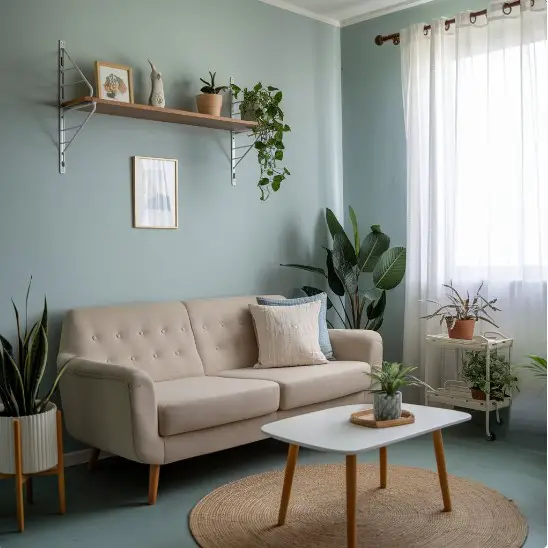Looking to refresh your living room while being kind to the planet?
Eco-friendly décor can transform your space into a stylish and sustainable haven.
This guide shares practical tips to help you create a beautiful, environmentally conscious living room that showcases your commitment to sustainability.
Let’s get started!

Image by our editorial team
Eco-Friendly Décor Tips: Create a Sustainable Living Room Today
1. Use Reclaimed Wood Furniture

Opt for reclaimed wood furniture pieces like coffee tables, shelves, or TV stands to minimize environmental impact.
Reclaimed wood gives your living room a rustic, chic look while promoting sustainability by reusing materials instead of relying on new ones.
This eco-friendly choice can also add warmth and character to your space, helping to create a unique and stylish living area.
2. Choose Organic Cotton or Linen Upholstery

When choosing fabrics for your sofas, chairs, or cushions, look for organic cotton or linen.
These natural fibers are grown without harmful pesticides, making them safer for the environment and your home.
Organic fabrics are durable, breathable, and hypoallergenic, making them perfect for a comfortable and healthy living room that aligns with eco-conscious values.
3. Embrace Energy-Efficient Lighting

Switching to LED or CFL bulbs reduces energy consumption while providing excellent illumination.
Incorporate energy-efficient lighting options into your décor, such as stylish floor lamps or pendant lights.
This simple change lowers your electricity bills and minimizes your carbon footprint.
Additionally, lighting with a warm tone can enhance the coziness of your living room without sacrificing sustainability.
4. Incorporate Plants for Air Purification

Houseplants like spider plants, peace lilies, or snake plants are not only visually appealing but also help purify indoor air by filtering out toxins.
Adding greenery to your living room enhances the décor and improves air quality, making your home healthier and more eco-friendly.
Choose plants that thrive indoors with minimal water requirements to ensure low maintenance.
5. Upcycle Old Décor Items

Before buying new decorations, consider upcycling or repurposing items you already own.
Transform old jars into vases or paint wooden crates to use as storage solutions.
This creative approach reduces waste and adds a personalized touch to your space, reflecting both your style and your commitment to sustainability.
Upcycling also adds unique, one-of-a-kind pieces to your décor.
6. Install Bamboo Flooring

Bamboo is an excellent sustainable alternative to traditional hardwood flooring. It grows faster and regenerates quickly, making it a renewable resource.
Bamboo flooring is durable, stylish, and easy to maintain, offering a natural aesthetic that complements eco-friendly living rooms.
Its subtle textures and variety of tones can enhance the overall ambiance while supporting sustainable living choices.
7. Use VOC-Free Paint

When refreshing your living room walls, opt for low or zero-VOC (Volatile Organic Compound) paints.
These paints release fewer toxic chemicals into the air, improving indoor air quality and reducing harmful environmental emissions.
VOC-free paints come in a variety of colors and finishes, allowing you to achieve the desired look for your space while maintaining a health-conscious, sustainable home.
8. Opt for Second-Hand or Vintage Furniture

Instead of purchasing brand-new furniture, consider sourcing second-hand or vintage pieces.
Not only does this reduce the demand for new resources, but it also gives your living room a unique, timeless feel.
Thrift stores, online marketplaces, or antique shops often have a variety of high-quality, eco-friendly options that add character to your space while promoting sustainability.
9. Choose Sustainable Wall Art

Support eco-friendly artists by choosing wall art made from sustainable or recycled materials.
Look for prints made with water-based inks or frames crafted from reclaimed wood.
This small change can make a big impact on reducing waste and promoting greener practices in your living room.
Plus, sustainable art pieces can serve as conversation starters, highlighting your commitment to an eco-conscious lifestyle.
10. Add Natural Fiber Rugs

Rugs made from natural materials like jute, sisal, or wool are great eco-friendly options.
These fibers are renewable and biodegradable, making them sustainable alternatives to synthetic materials.
A natural fiber rug not only adds texture and warmth to your living room but also contributes to creating a more eco-conscious home, making it a stylish and responsible choice.
FAQs
1. What is the most eco-friendly furniture material?
Reclaimed wood, bamboo, and recycled metal are some of the most eco-friendly materials.
These materials reduce waste and the demand for new resources, making them sustainable choices for home décor.
2. How can I make my living room décor more sustainable?
Use eco-friendly materials like organic fabrics, reclaimed wood, and natural fiber rugs.
Incorporate energy-efficient lighting and choose second-hand or upcycled furniture to reduce your environmental impact.
3. Why is VOC-free paint important?
VOC-free paint helps maintain better indoor air quality by reducing harmful chemical emissions.
It’s a healthier choice for your home, especially for families with children or those sensitive to strong odors.
The Wind-Up
Creating a sustainable living room doesn’t mean sacrificing style or comfort.
By incorporating eco-friendly materials like reclaimed wood, organic fabrics, energy-efficient lighting, and plants, you can enjoy a beautiful, environmentally conscious space.
Start with small changes, and soon, your living room will reflect your commitment to sustainability.

